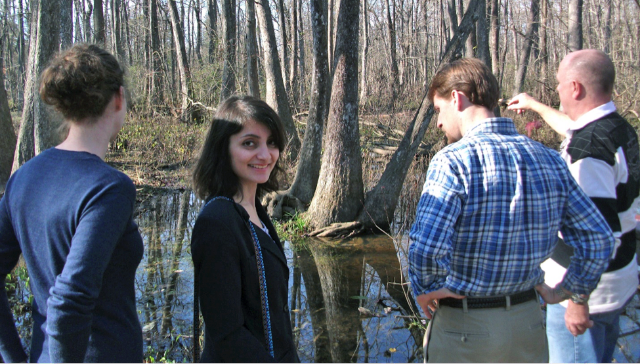Nafplio is a port town and one of my faves in Greece. It is situated on the Argolic Gulf in the northeast Peloponnese. The city has a great deal of Venetian and Ottoman influence, and is very colorful. In the main plaza, you can see a number of colorful restaurants and cafes, and a beach that you can walk to in ten minutes. It's only a 2 hour drive in Athens, and I suggest that for a shorter stay, you can make Nafplio your base. The benefit is that all the other important ancient sites of Myceneae, Epidauros, Argos and Corinth are close by.
The main tourist area is the Syntagma or Constitution Square, which is an arena that is closed off to cars. It is paved in marble and surrounded by historical buildings. I saw a building that looked like a mosque there, and upon asking, found out is was a mosque left over from the times of the Ottomans. Some very popular cafes, and shops are in the area. The streets are colorful and well lit, filled with people casually strolling. We also had some glorious food.

Our next stop was the Palamidi Forestes, one of the two fortresses in the city. The Venetians and the Franks had transformed this part into one of the town fortifications. One of the fortifications of the city include the Palamidi, which is located in the middle of the harbour. To reach the top of the fortress there are over one thousand steps. Locals in the town of Nafplion will say there are 999 steps to the top of the castle, and specials can be found on menus that incorporate this number to catch a tourist's eye. An advice is to bring some extra water bottles as getting up some 900 or so steps is no easy task. Take breaks and enjoy the view.

The main tourist area is the Syntagma or Constitution Square, which is an arena that is closed off to cars. It is paved in marble and surrounded by historical buildings. I saw a building that looked like a mosque there, and upon asking, found out is was a mosque left over from the times of the Ottomans. Some very popular cafes, and shops are in the area. The streets are colorful and well lit, filled with people casually strolling. We also had some glorious food.

Hands down, Greek food is one of my favorites (better than Korean, Cambodian, Pakistani/Indian or Turkish). The only thing that comes close to Greek food is Sri Lankan food, which I found to be a delightfully fresh cuisine, and not as oily as its South Asian counterparts. And food was not complete without Greek desserts. I wasn't a big fan as these are too oily and sweet. They were a lot like Turkish desserts like baklava.
Our next stop was the Palamidi Forestes, one of the two fortresses in the city. The Venetians and the Franks had transformed this part into one of the town fortifications. One of the fortifications of the city include the Palamidi, which is located in the middle of the harbour. To reach the top of the fortress there are over one thousand steps. Locals in the town of Nafplion will say there are 999 steps to the top of the castle, and specials can be found on menus that incorporate this number to catch a tourist's eye. An advice is to bring some extra water bottles as getting up some 900 or so steps is no easy task. Take breaks and enjoy the view.
The hill of Palamidi takes its name from the Homeric hero Palamidis and it was only later that it be came a part of Nafplio. In fact, Nafplio was first captured by the Venetians in 1470. During this period, the Venetians strengthened the castle of Akronafplia without Palamidi. Then, in 1540, Nafplion was captured by the Turks. It was then that for the first time, Palamidi was strategically exploited, although still inadvertent, by the Vizier Kasim Pasha, who during the three-year siege of Nafplion devised the city from there. The Venetians returned in 1686 and under Morozini they regained the area, and after a fierce battle to occupy the Palamidi Hill. The Venetians then realized the strategic importance of many Greek ports, including Nafplion, and valued the location of the Palamidi rock, which naturally protected the entrance of the Argolic Gulf.
The construction of the fort was basically carried out during the time of Venetian General Superintendent of the Fleet, Agostino Sagredo, from 1711 to 1714, marking the fort not only as a major feat in terms of its fortifications, but also in terms of the speed with which it was constructed. Since then the castle has played an important role in the history of the area.
The fort of the Palamidi has been preserved in excellent condition, is one of the greatest achievements of Venetian fortification. It is a typical baroque fortress based on the plans of the engineers Giaxich and Lasalle. In 1715 it was captured by the Turks and remained under their control until 1822, when it was captured by the Greeks.
The eight bastions of the fortress were originally named after the Venetian provveditori (the local governors). However, when it fell to the Ottoman Empire, they were given Turkish names. Lastly, when the Greeks overthrew the Turks the bastions were renamed after ancient Greek leaders and heroes (Epaminondas, Miltiades, Leonidas, Phocion, Achilles, Themistocles. The two remaining bastions were named after St. Andrew (Agios Andreas) and the French Philhellene Robert who died in battle on the Acropolis of Athens. The "Miltiades," was used as a prison and among its walls was also held Theodoros Kolokotronis, hero of the Greek Revolution.
The fortress commands an impressive view over the Argolic Gulf, the city of Náfplio and the surrounding country.










0 comments